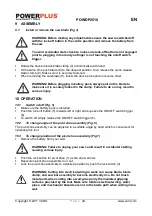
POWDP2510
EN
Copyright © 2017 VARO
P a g e
|
9
www.varo.com
10.4
LED work-light (Fig. 8)
The LED work light (3) can light prior to motor running if you press the switch lightly, which
keep the work area to be lighted for checking clearly at first, and it lights also during your
operation.
NOTE: The LED work-light delay about 5s to extinguish after turn off the
tool.
WARNING: Do not stare directly at the light beam. Never aim the beam at
any person or an object other than the work piece.
Do not deliberately aim the beam at personnel and ensure that it is not
directed towards the eye of a person for longer than 0.25s.
11 GENERAL OPERATING INSTRUCTIONS
Slide a fully charged battery pack into the bottom of the handle, making sure that it clicks
into place. Be sure the battery pack is securely seated into the saw handle so it will not fall
off during use.
Firmly hold the reciprocating saw with both hands. Position the Blade near the work piece,
depress the lock-off button (5) and hold the ON/OFF switch trigger (6) down.
Release the lock-off button once the tool has power. Allow the saw to come up to full
speed before addressing it to the work piece.
IMPORTANT: Do not start the saw if the saw blade is in contact with
anything before operation. If necessary, lift the tool from the work piece
before squeezing the ON/OFF switch trigger.
In preparation for making a cut, place the pivot shoe assembly (1) on the surface to be cut.
Align the saw blade with the direction of the cut and slowly lower the saw blade onto the
cut line to begin the cut. Do not attempt to cut with the tip of the blade; kickback and
damage to the blade could result.
When finished cutting, release the ON/OFF switch trigger to stop the tool.
Remove the battery pack and the saw blade.
Clean, then store the saw indoors
and out of children’s reach.
11.1
General cutting
Clamp your work piece if it is portable. Rest the front shoe of the saw on your work piece (be
sure the blade is not contacting the work piece) and start the saw, exerting enough pressure in
the direction of the cut to keep the shoe pressed firmly against the work piece at all times. Do
not force the cut or stall the saw. Don’t bend or twist the blade, let the tool and the blade do
the work.
In general, coarser blades are for wood, plastics, and composites, and finer blades are for
cutting metal. Chattering or vibration may indicate you need a finer blade or higher speed. If
the blade overheats or clogs, it may indicate you need a coarser blade. Replace blades when
they become dull. Dull blades will produce poor results and may overheat the saw.
11.2
Plunge cutting
Clearly mark the line of cut, from a convenient starting point within the cut out area. Place the
tip of the blade over that point with saw parallel to the line of cut, slowly lower the saw until the
bottom edge of the shoe rests on the work piece and the blade is not touching the work piece.
Start the saw and allow it to attain full speed. With the saw resting on the shoe, slowly tilt the






























